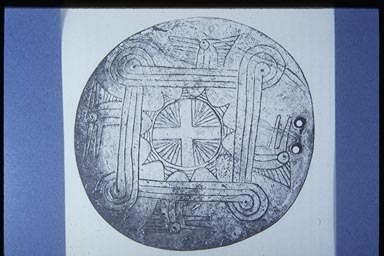Home Page
A VISUAL TOUR OF GEORGIA'S PREHISTORIC PAST:
INDIAN TECHNOLOGY FROM 9,500 B.C. to A.D. 1540
Page 4
This inscribed shell "gorget" dates to between approximately A.D. 1250 and A.D. 1350. In archaeological terms, this era is known as the "Middle Mississippian period." The ornate material culture associated with Middle Mississippian ceremonialism is collectively referred to as the "Southeastern Ceremonial Complex."
The iconography of this gorget expresses aspects of worldly and religious views held by the prehistoric Indians that built earthen mounds at locations that served as political centers. These mounds were occupied by "priests" and "chiefs" that resided in and/or ruled from structures built on the mound summits.
Some of the more well-known mound centers include Etowah, Moundville, and Cahokia, which are respectively located in Georgia, Alabama, and Illinois. These are just three of the many such places that exist throughout the Southeast and Midwest, however.


This copper bead was made from unsmelted, malleated copper ore. It was recovered in Rockdale County, Georgia (near Atlanta) from contexts that date to approximately A.D. 200.
To Page 3 of the Visual Tour